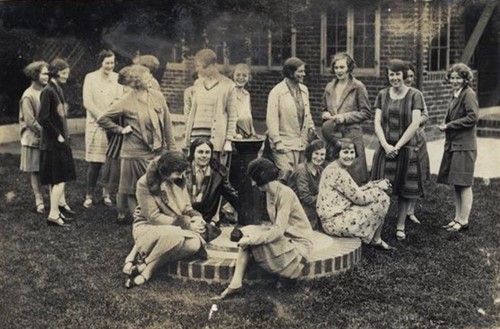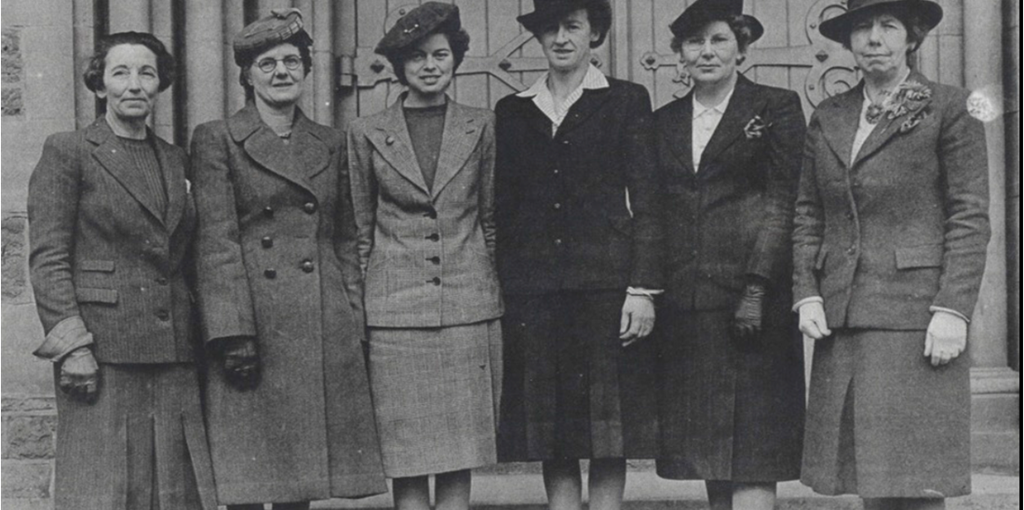A national meeting. Audrey Newton third left, Enid Wilson far left
The history of early childhood is a tapestry created by voices that have been famous and many more that have worked unheralded in communities throughout the world with children and families. We are weavers of the unbroken thread; we are the voices of early childhood.
Jennifer Wolfe, Learning from the past: Historical voice in early childhood education,
(2nd Edition) Piney Branch Press, 2000, 396
Celebrating our people
We acknowledge, record and celebrate the women and men, who in diverse ways, have have made an impact on kindergarten education from 1879 to recent times. They are the voice of kindergarten who, to adapt Wolfe’s term, represent the weavers of the unbroken thread in the tapestry, or perhaps here, the mat of kindergarten history. The photo of women attending a national meeting (above) taken around 1928, represents biographical connections within kindergarten, both past and the future. The past is represented in the image of the sundial erected in 1922 by Wellington’s Free Kindergarten Union in honour of the founder of free kindergarten in Wellington, Mary Richmond. The women clustered around the sundial – said to be trainee teachers - represent the then new and the future in kindergarten. This section expands the tapestry’s warp and to weave in a wider diversity of individual narrative stories as a means for sharing and interpreting experience.

Women sitting around sundial built to honour Mary Richmond. ca 1928. ‘A group of student Kindergarten teachers’, Wellington Free Kindergarten Association, Alexander Turnbull Library, PAColl-0981-1 -08-2
Whilst it is widely acknowledged that the early education of young children is an overwhelmingly female dominated profession, women’s views and aspirations, hidden by a long history of neglect, remain largely unknown or are trivialised resulting in a partial history of kindergarten in New Zealand. The contributions of some pioneers and leaders have been partially acknowledged in historical accounts, but less so than that of other groups such as teachers and volunteers working at the local level. It is critical to consider the way in which we determine which lives count as notable, significant, or valuable and having done so, ensure representative stories are retrieved and recorded.
The stories here are of individuals who, together with others, helped shape pedagogical, political and professional growth in kindergarten. They include parents, volunteers, political leaders, teacher educators, pedagogical leaders, policy makers and managers as well as volunteers in kindergarten. Their particular stories are told. Teachers for example talk of their everyday work with children and their families to reveal many stories of innovation, struggle and moments of achievement and their own development and growth as teachers and pedagogical leaders. Political leaders talk of their work with officials and the community to effect political change and volunteers talk of the struggles to fund raise and to establish new kindergartens, to identify a few of the topics raised. The scope of experience included spans beyond the free kindergarten movement to include individuals connected to related organisations and institutions such as private kindergartens and junior school teachers involved in implementation of kindergarten pedagogy.
We include biographies and other approaches that typically take as a focus, an individual’s personal story and its public meaning. Some authors effectively capture the subject in under 500 words while others are longer and provide greater detail. Other authors use autobiographical essays, oral interviews and memoirs. Visual methods using images with limited text in a presentation or an online album provide alternative approaches, as do comic strips and poetry. Which ever method is used, it is important to also capture some the spirit of the time in which the subject lived.


